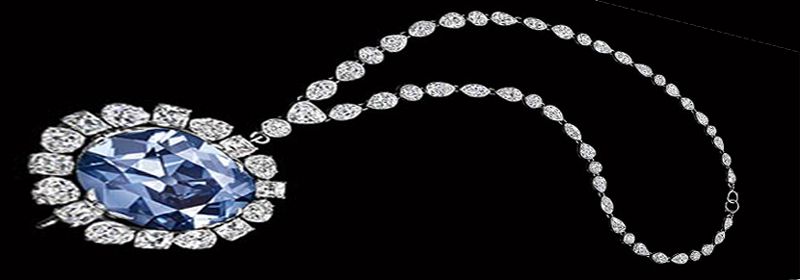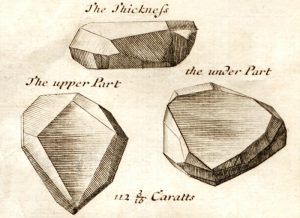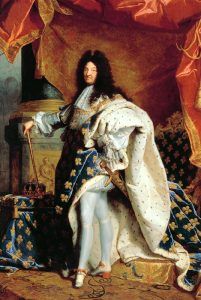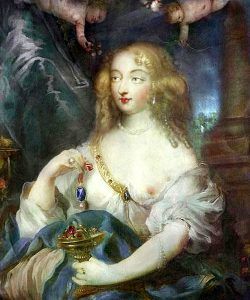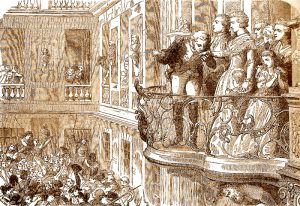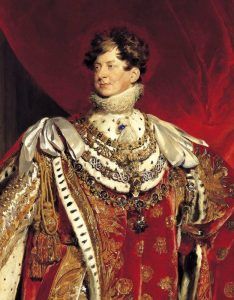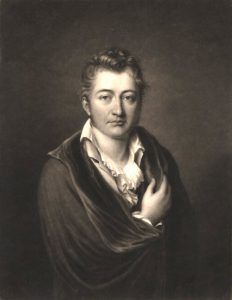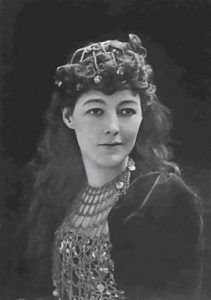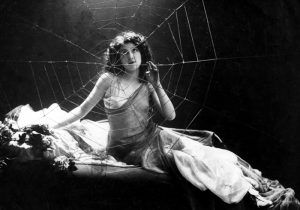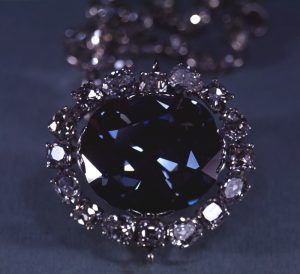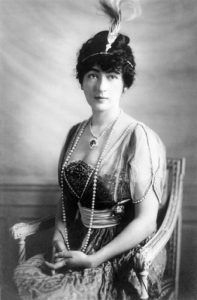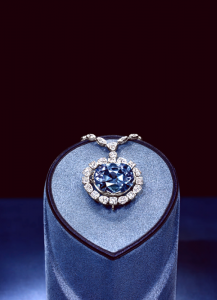“You cradle the 45.5-carat stone—about the size of a walnut and heavier than its translucence makes it appear—turning it from side to side as the light flashes from its facets, knowing it’s the hardest natural material yet fearful of dropping it.”
— Associated Press reporter Ron Edmonds in 2003
The Hope Diamond, one of the most famous jewels in the world, has a history dating back almost four centuries. The beautiful 45.52 blue diamond is also said to be cursed, bringing misfortune and tragedy to its many owners over the years.
The jewel is believed to have originated in India, probably from the Kollur Mine in Golconda sometime during the early 1600s. In 1630, French gem merchant Jean-Baptiste Tavernier began making a series of six voyages from France to Persia and India to trade in precious stones and other high-end wares. At some point, between the years 1640 and 1667, he obtained a 115 carat (nearly the size of man’s fist) precious stone that was somewhat triangular in shape, crudely cut, and described by Tavernier as a “beautiful violet.” Though the merchant documented his travels and the gems that he collected over the years, he did not state from whom, or when he obtained the large blue diamond that became known as the “Tavernier Blue.”
Early legend says that Tavernier stole the diamond from a Hindu temple, where it was set as one of two matching eyes of an idol, and afterward, the temple priests laid a curse on whoever might possess the missing stone.
Tavernier returned to Paris on his final voyage in 1668 and, the same year, sold the large blue diamond to French King Louis XIV, along with 14 other large diamonds and several smaller ones. His final voyages secured for him a large fortune and great reputation at home. In 1669, he received patents of nobility, and the following year, he purchased a large estate near Geneva, Switzerland, and spent his next years writing and publishing accounts of his journeys. In the end, if the diamond was cursed, it did not seem to affect Tavernier, who lived a comfortable life until his death at the age of 84.
In the meantime, King Louis XIV commissioned the court jeweler Jean Pitau to recut the Tavernier Blue to “make him a piece to remember” in 1673. The large blue diamond was then cut almost in half, resulting in a 69 carat stone. The royal inventories described its color as an intense steely-blue, and the stone became known as the “Blue Diamond of the Crown,” or the “French Blue.” Pitau spent two years on the piece, resulting in a “triangular-shaped 69-carat gem the size of a pigeon’s egg that took the breath away as it snared the light, reflecting it in bluish-grey rays.” When complete, the diamond was set in a gold cravat pin that received additional support from a ribbon worn around the neck, which the king wore on ceremonial occasions.
“At the diamond’s dazzling heart was a sun with seven facets – the sun being Louis’ emblem, and seven being a number rich in meaning in biblical cosmology, indicating divinity and spirituality.”
— Agence France-Presse, 2008
Whether he was affected by the curse, King Louis XIV suffered when all of his legitimate children, but one, died in childhood. Though he tried to project an image of a healthy and virile king, he suffered several ailments in his life, including symptoms of diabetes, recurring boils, fainting spells, gout, dizziness, hot flushes, headaches, and underwent a painful operation. However, his reign of 72 years and 110 days is the longest recorded of any monarch of a sovereign country in European history. During Louis’ long reign, France was the leading European power, fought three major wars and two lesser conflicts. He died of gangrene four days before his 77th birthday. Upon his death in 1715, his title and estate, including the Blue Diamond, were inherited by his five-year-old great-grandson, King Louis XV.
During King Louis XIV’s reign, another man who is said to have been affected by the curse was Nicholas Fouquet, the superintendent of the country’s finances. For a special occasion, Fouquet was allowed to wear the precious stone. He and the king argued a short time later, and Fouquet was soon charged with maladministration of the state’s funds. Fouquet was then imprisoned at the Fortress of Pignerol in 1664, where he stayed until his death in 1680.
Another person said to have been cursed by the diamond during King Louis XIV’s reign was his chief mistress, Madame de Montespan, with whom he had seven children. His mistress, whose name was Francoise-Athenaïs de Rochechouart, was from one of the oldest noble families of France and grew up to marry French Nobleman Louis Henri de Pardaillan de Gondrin, the Marquis of Montespan. The couple lived in a small house close to the Louvre, which allowed Madame de Montespan to attend court often, where she quickly established herself as the “reigning beauty of the court.” She was also cultured, an amusing conversationalist, intelligent, and kept abreast of political events. The Marquise de Montespan first danced with King Louis XIV at a ball at the Louvre Palace and soon developed a romantic relationship. By 1667, she was called by some the “true Queen of France” due to her pervasiveness and influence at court. She was also known for openly disrespecting Queen Maria Theresa in public. But the King did not admonish her and was so enamored of her that she was painted holding the Blue Diamond of the Crown. She also reputedly wore the diamond several times in public.
Due to the open royal adultery, the Roman Catholic Church soon became her adversary. In 1675, a priest refused to give her absolution, which was necessary to take Easter communion, a requisite for all Catholics.
“Is this the Madame that scandalizes all France? Go abandon your shocking life and then come throw yourself at the feet of the ministers of Jesus Christ.”
— Father Lécuyer
Though the King appealed to the priest’s superiors, the Church refused to yield to the king’s demands. Afterward, the pair stopped seeing each other for a brief period before they resumed their relationship. However, it wouldn’t last. In 1679, Montespan was accused of using witchcraft and aphrodisiacs to stay ahead of King Louis’s other lovers. One of her accusers even alleged that Montespan performed black masses, a sacrilegious accusation that effectively destroyed Montespan’s reputation. Fearful of his reputation, the King stopped seeing her publically but discreetly continued to visit her until 1691, when he retired her to the Filles de Saint-Joseph Convent. When she died in May 1707, at the age of 66, the king forbade her children to wear mourning for her.
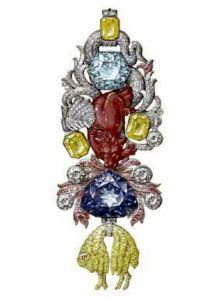
French King Louis XV had the blue diamond reworked into a ceremonial piece for the Royal Order of the Golden Fleece.
In 1715, King Louis XV took the throne at the age of five, but the kingdom was ruled by Philippe II, the Duke of Orleans, until the king reached the age of 13. He married when he was just 15, and the couple had ten children, but only seven would live to adulthood. He also had as many as a dozen illegitimate children. During his early years, King Louis XV was well regarded and earned the nickname “Louis the Well-Beloved.” In 1749, the king had the Blue Diamond reset by court jeweler Andre Jacquemin in a piece of ceremonial jewelry for the Royal Order of the Golden Fleece.
Unfortunately, his political actions and stubborn personality would earn him the contempt of his subjects in the following years. His lack of strength during the Seven Years’ War that lasted from 1756 and 1763 resulted in France losing nearly all of its colonial possessions in North America and India. During this time, he was also accused of damaging France’s foreign relations and continuously overspending. Though King Louis XV had the second-longest reign in the history of France, exceeded only by his predecessor and great-grandfather, Louis XIV, historians generally give his reign very low marks because wars drained the treasury, and his actions contributed to the decline of royal authority that led to the French Revolution in 1789. Louis XV died a hated man in May 1774, and the throne was succeeded by his grandson, Louis XVI.
Louis XVI was just 20 years old when he assumed the throne and was still immature, lacking in self-confidence, and austere in manner. With these traits, he assumed the responsibilities of running a nation that was heavily in debt. His approval of the French military and financial support of the colonists in the American Revolution led to foreign policy success. Still, the borrowing required to pay for the war drove the government to the brink of bankruptcy. This led the king to support radical fiscal, economic, and administrative reforms during the age of Enlightenment, which encouraged individual liberty and religious tolerance and opposed an absolute monarchy and the fixed dogmas of the Roman Catholic Church. The King’s support of radical fiscal reforms were not favorable to the nobles or the people. Making matters worse, the French people loathed the King’s wife, Marie Antoinette, who was accused of being promiscuous, sympathetic to French enemies, frivolous, and extravagant, which discredited the monarchy.
The friction within the country led to the French Revolution. On October 5, 1789, an angry mob of Parisian working men and women marched on the Palace of Versailles and forcibly moved the royal family to Paris because they felt the King would be more accountable to the people if he lived among them. Afterward, Louis ignored advice from advisors and refused to abdicate the throne. To avert the deepening crisis, Louis agreed to summon the “estates-general” (a form of parliament, but without real power). Still, he refused to allow the state, church, and estates-general to meet simultaneously, causing the Third Estate to proclaim itself a national assembly and declaring that only it had the right to represent the nation.
In June 1791, the royal family attempted to escape, but they were soon brought back to Paris, by which time the King had lost all credibility as a monarch. In September 1792, the new National Convention abolished the monarchy and declared France a republic. Later, King Louis XVI was found guilty of treason and executed at the guillotine on January 21, 1793. His wife, Marie Antoinette, was executed nine months later.
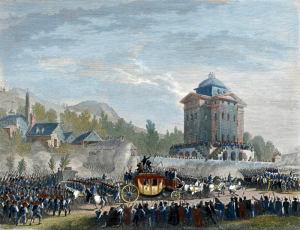
King Louis XIV and the royal family were ca[tured and returned to Paris after they tried to escape in 1791.
In the meantime, the jewels of the French Royal Treasury had been turned over to the new government. During a week-long looting of the crown jewels in September 1792, the French Blue Diamond was stolen. While many jewels were later recovered, including other pieces of the Order of the Golden Fleece, the French Blue was not among them, and it disappeared from history.
During the missing years, a Dutch diamond cutter named Wilhelm Fals somehow obtained the diamond recut the precious stone to hide the jewel’s identity. On completion, the 69 carat stone was reduced to the 45 carat Blue Hope Diamond we see today. When it was in Fals’ possession, his son, Hendrik, stole the gem ruining his father, who was said to have died in grief. Hendrick Falls then gave the diamond to a man named Francis Beaulieu in payment of a debt. Beaulieu then traveled from Marseille, France, to London, England, to sell the diamond to jewel dealer Daniel Eliason. However, when the jeweler went to pay Beaulieu he found him dead in a lodging house, succumbing to fever. Years later, Hendrik Fals killed himself in 1830.
In the meantime, the public was unaware of the whereabouts of the beautiful blue diamond until a man named John Francillion documented that a large blue diamond was in London, England, in 1812. He described that the stone, weighing over 45 carats, was in possession of a London diamond merchant Daniel Eliason and the gem was for sale. Because of its size and unusual color, the stone suggested that it was recut from the French Blue stolen ten years previously. Shortly afterward, the jeweler, Daniel Eliason, committed suicide.
In 1822, a portrait of King George IV of England was painted in which the King was wearing the insignia of the Royal Order of the Golden Fleece set with a large blue stone bearing a striking resemblance to the French Blue diamond. When King George died in 1830, his estate was encumbered by outstanding debt, and it is thought that the diamond, along with other jewelry and personal effects, were sold to cover the many debts he had left behind.
In 1839, a large blue diamond appeared in the gem catalog of Henry Philip Hope, a London banker. At this time, the jewel became known as the “Hope Diamond.” After Hope died in 1839 and litigation within the family, the stone was passed on to his nephew, Henry Thomas Hope, in 1841. Later the precious stone would pass to Henry Thomas Hope’s grandson, Lord Francis Hope, who lived beyond his means.
In 1894, Lord Francis Hope met American concert hall singer May Yohé, and the two married the same year. By the time they married, Hope was nearly bankrupt. Still, the pair ignored financial problems and lived lavishly, gambled, and often traveled, squandering everything he had left, including jewelry, heirlooms, pictures, art, and land. He then began to borrow money, sending him into even further decline. In 1900 they made a tour of the world, and on their way home, met Captain Putnam Bradlee Strong, a handsome and popular man in the United States Army. Yohe fell head over heels in love with the dashing captain and refused to return to England with Lord Francis.
In 1901 Lord Francis Hope sold the Blue Diamond to help pay off his debts, and the following year, he claimed bankruptcy, lost his foot in a hunting accident, and divorced May Yohé. Hope remarried in 1904, had three children, inherited dukedom from his brother in 1928, and died a poor man in 1941 at the age of 75.
During their marriage, Yohe was known to have worn the diamond at least once, but she later claimed she had worn it at several social gatherings, although Lord Francis claimed otherwise. After she and Francis Hope divorced, she married the handsome Army captain but was divorced just a few years later. Afterward, she maintained a stage career off and on and married several more times. As the years went by, she was reduced to working as a housekeeper and a clerk. She died in poverty in 1938 at the age of 72.
By the 1900s, stories of the diamond’s curse had been flourishing for years, with some saying that the original form of the Hope Diamond was stolen from the eye of a sculpted statue of the goddess Sita, the wife of Rama, a principal deity of Hinduism. Though many believed the precious stone was cursed due to its owners’ many tragedies, others felt strongly that these tales were perpetuated to add mystique to the stone, increase its sales appeal, and increase newspaper sales.
In 1901, the stone was sold by Lord Francis Hope to Adolph Weil, a London jewel merchant, who, in turn, sold it to diamond dealer Simon Frankel, in New York for $148,000. In some versions of its history, Frankel kept the diamond until he sold it to Salomon Habib, a wealthy Turkish diamond collector, in 1908. However, other versions say that between 1901 and 1908, the stone was bought and sold several times.
Allegedly, the first to purchase it was French banker Jaques Colet, who bought the Hope Diamond from Simon Frankel, and just a short time later, Colet went mad and committed suicide.
Afterward, it was sold to Russian Prince Ivan Kanitowsky, who loaned it to his lover, actress Lorens Ladue. The first time she wore the diamond on stage, she was shot by a man in the audience that many people said was the Russian prince himself. Just a few weeks later, Kanitowsky was stabbed to death in Paris by Russian revolutionaries.
By this time, the legend of the curse had increased, and an article entitled “Hope Diamond Has Brought Trouble To All Who Have Owned It” appeared in the Washington Post in 1908. The same year, the stone was back in possession of the Frankels, who made a concerted effort to sell what they called the “hood diamond.” The following person to acquire it was a well-known Greek jewel broker named Simon Maoncharides, who acquired the stone in late 1908. He quickly sold the diamond to Habib Bey, a Persian diamond merchant. On the night that the deal was concluded, Maoncharides accidentally drove his carriage over a precipice, killing himself, his wife, and child.
Afterward, Habib Bey quickly sold the stone to Salomon Habib, acting on behalf of Abdul Hamid II, the Sultan of Turkey. Within months Habib Bey drowned during the sinking of a French steamer in 1909.
Abdul Hamid II, known as “Abdul the Damned,” gave the Hope Diamond to his favorite concubine, Salma Zubayaba, with orders that it be protected by Kulub Bey, his favorite eunuch, and guardian of the Sultan’s treasures. A few months later, Zubayaba was stabbed and killed by a low-level official in the treasury who tried to steal the gem. The thief, Jehver Agha, was caught by Kulub Bey and hanged after being tortured. Another man named Abu Sabir, who was tasked with polishing the stone for the Sultan was unfairly accused of working with Jehver Agha and was tortured and executed.
Shortly after this incident, Abdul Hamid II was overthrown during the Young Turks Rebellion of April 1909. The sultan was later captured and imprisoned at Beylerbeyi Palace in Istanbul, Turkey. Legend has it that Kulub Bey was captured by a mob after the uprising and slowly strangled to death.
Afterward, the stone was sold to Parisian jewel merchant Simon Rosenau who sold it in 1910 to Pierre Cartier, a French jeweler who owned one of the most respected firms in Paris, London, and New York. That year, Cartier tried to sell it to American mining heiress and socialite Evalyn Walsh McLean. At that time, she wasn’t interested. However, when Cartier reset the diamond into a more modern piece, he sold it to Edward B. McLean on behalf of his wife Evalyn in January 1911 for $180,000. Though both Edward and Evalyn had been warned not to buy the diamond by Edward’s mother and May Yohe, the sale went through. However, it was not an easy sale, as negotiations took several months, which got mired down in a lawsuit, and the buyers required a blessing by a priest.
Evalyn mocked the curse joking that things that brought other people bad luck brought her good luck. Perhaps Edward wasn’t convinced though, as the original contract with Cartier included a clause stating: “Should any fatality occur to the family of Edward B. McLean within six months, the said Hope Diamond is agreed to be exchanged for jewelry of equal value.”
A description of the gemstone stated: it “lay on a bed of white silk and surrounded by many small white diamonds cut pear-shaped.”
“Both Ned McLean and his pretty wife are quite young and in a way unsophisticated, although they were born and reared in an atmosphere of wealth and luxury. All their lives, they have known more of jewelry, finery, banquets, automobiles, horses, and other articles of pleasure than they have of books, with their wealth of knowledge.”
— The New York Times, March 1911
Mrs. McLean wore it the diamond publically for the first time to a reception in February 1912. Afterward, she would be seen wearing the precious stone at numerous social events. A bail was soldered to the pendant where Mrs. McLean would often attach other diamonds, including the McLean Diamond and the Star of the East.
Though Evalyn joked about the curse and kept the diamond until the end of her life, numerous tragedies occurred during her lifetime.
Shortly after she got the diamond her mother-in-law died. In 1919, her nine-year-old son, Vinson, ran in front of a car and was killed. In 1929, Edward McLean went off with another woman and even claimed to have married her, but he hadn’t. In the meantime, both Edward and Evalyn continued to spend lavishly and were divorced in 1932.
The following year, Edward McLean’s increasingly erratic behavior and reckless spending led to the forced sale of The Washington Post newspaper in 1933, which he had inherited in 1916. The same year, Edward was declared legally insane due to brain atrophy brought on by alcoholism. The court ordered that he be committed indefinitely to a psychiatric hospital. He was never released and died in 1941. In 1946, Evalyn’s only daughter died of an accidental overdose of sleeping pills at the age of 25. The following year, Evalyn died of pneumonia at the age of 60.
Mrs. McLean bequeathed the Hope Diamond to her grandchildren with the requirement that it would remain in the custody of trustees until the eldest child reached 25 years of age. This would have prevented any sale for the next two decades. However, Evalyn died deeply in debt, and the trustees gained permission to sell her jewels to settle her debts. In 1949, her jewel collection was sold to New York diamond merchant Harry Winston. In addition to the Hope diamond, the collection also included the 94.8-carat Star of the East diamond, the 15-carat Star of the South diamond, a 9-carat green diamond, and a 31-carat diamond which is now called the McLean Diamond.
For the next ten years, the Hope diamond was shown at many exhibits and charitable events worldwide. In November 1958, Winston donated the Hope Diamond to the Smithsonian Institution to help establish a national jewel collection.
Allegedly, there was one last victim of the diamond’s curse — a postman named James Todd. After promising to donate the diamond, Winston sent it through the U.S. Mail from New York to Washington, D.C. After Todd delivered the package, he crashed his truck and shattered his leg. He then got in another crash, injuring his head. He also lost his wife and dog to untimely deaths, and afterward, part of his house burned down.
Since the Smithsonian acquired the gemstone, the “curse appears to have gone dormant,” and for decades, the Hope Diamond and the rest of the museum’s gem collection have brought only good luck to the museum with higher attendance.
Owning the diamond has brought “nothing but good luck” for the nonprofit national museum, according to a Smithsonian curator. It has helped it build a “world-class gem collection” with rising attendance levels.
Today, the Hope Diamond, described as the “most famous diamond in the world,” is exhibited in the Harry Winston Room in the Hall of Geology, Gems, and Minerals of the Natural History Museum of the Smithsonian Institution in Washington, D.C. In the pendant surrounding the Hope Diamond are 16 white diamonds. The necklace chain contains 45 white diamonds. It was last reported to be insured for $250 million.
© Kathy Weiser-Alexander/Legends of America, updated November 2021.
Also See:
Legends, Ghosts, Myths & Mysteries
Sources:
Aquiziam
Live Science
Smithsonian Institution
ThoughtCo
Public Broadcasting System
Time-Life Books, Mysteries of the Unknown
Wikipedia

